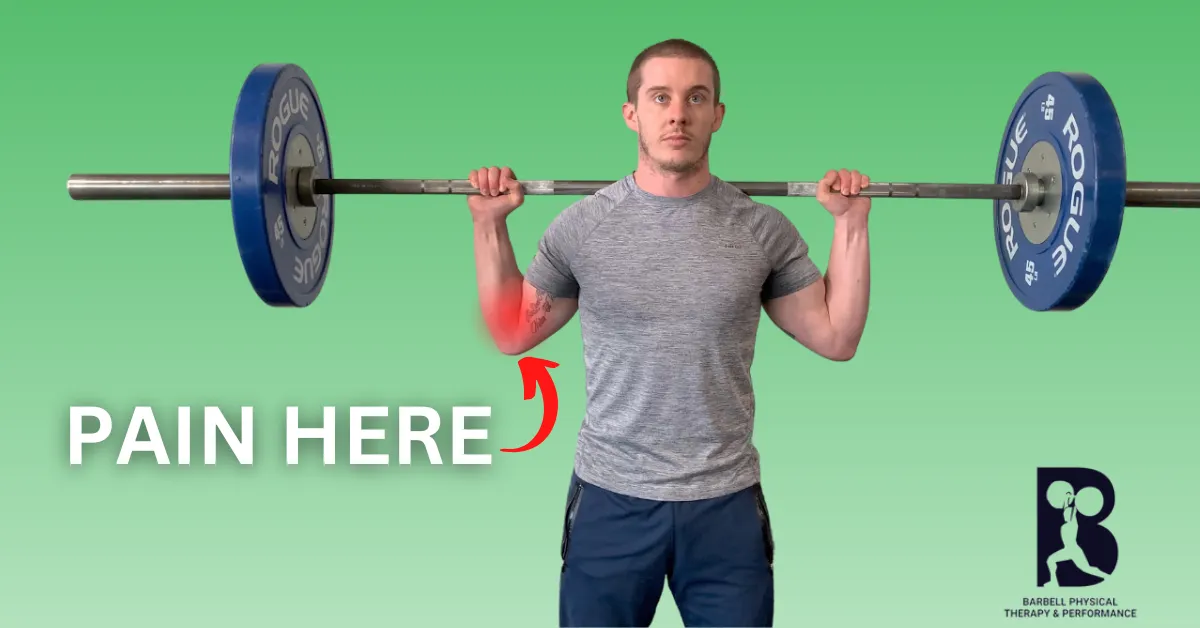Inner elbow pain is a common complaint that many lifters have. But, powerlifters who squat low bar tend to have this complaint at slightly higher rates.
When you’re squatting, you need to be able to properly secure the bar in the rack position. If you squat high bar, this would be across your upper traps, whereas if you squat low bar, this be across the rear delts.
In order to achieve either of these rack positions, you need an appropriate amount of shoulder external rotation flexibility, but if you squat low bar, you do need a little bit more flexibility in this position due to the differences in bar placement.
If you’re limited in external rotation flexibility of the shoulder, this can increase the valgus stress on the elbow, which can irritate those inner structures of the elbow, especially when coupled with high enough training volumes or intensities.
To test your shoulder external rotation flexibility, you’re going to lie on your back with your shoulder abducted between 45 and 90 degrees away from your side, and then you’re going to let your hand fall backwards as far to the floor as possible.
Ideally, we want to see the forearm become parallel with the floor below you, or ideally slightly below that parallel position. If you can’t reach at least parallel then you likely have some limitations in your shoulder external rotation flexibility, which can be increasing the stress on your elbow and contributing to the pain that you’re feeling in your elbow when squatting.
To solve this problem, we want to not only address the shoulder flexibility limitations that you have, but also make some temporary changes to your overall training structure while doing so.
To begin working on your shoulder external rotation flexibility, we’re going to stretch the shoulder one of two ways. The first way is to do a PVC external rotation stretch, in which you grab a PVC pipe, loop your arm around it and then grab the bottom of the pipe with the other arm and pull that up, stretching your shoulder back into external rotation.
You can also perform a rack pec stretch, which can be performed at a couple different angles of shoulder abduction based on where you feel the stretch the best and what is the most comfort on the front of the shoulder.
Some people feel the most amount of comfort at 90 degrees of abduction, some will feel better a little bit higher and some will feel better a little bit lower, so play around with positions until you find what works best for you.
We recommend that you hold each stretch for about 30 to 60 seconds and perform three to five reps of these per session or per set.
From here we’re going to progress to loaded stretching by performing supine shoulder external rotation eccentrics. To do this drill, we’re going to lie on your back with your shoulder abducted between 45 and 90 degrees. Hold a small weight in your hand and lower it towards the floor over a three to five second period, then hold that end range stretch for two to three seconds. We recommend performing three sets of six to eight reps of this drill.
Finally, we’ll work on end range strength and control of external rotation by performing some prone external rotation lift offs. To do this drill, you’re going to lie on your stomach with the shoulder abducted between 45 and 90 degrees and then you’re simply going to lift your hand as far away from the floor as possible, holding this position for five seconds for five reps, and performing three sets of this exercise.
We recommend performing these exercises all in a row as a series at least four to five times per week to truly improve your shoulder external rotation flexibility over the long term.
While performing these drills, it’s still important to stay active and stay training as much as possible. In order to do so, we’re going to do some specific training modifications.
You can reduce overall training volume or intensity while maintaining the same grip on the bar, or you can switch to different grips or bar placements that reduce the stress on the elbow as you’re going through these drills.
For example, if you squat low bar, you can switch to a high bar position or you can move your arms out a little bit wider, which will reduce that valgus stress on the elbow itself.
On the other hand, if your elbows are particularly sensitive, you can switch to an SSB squat or even a leg press to at least maintain or increase leg strength while avoiding stress on the already sensitized elbows.
As your shoulder flexibility improves and your elbows become less painful and sensitive, you can slowly progress back to your normal style of squatting and training overall.



